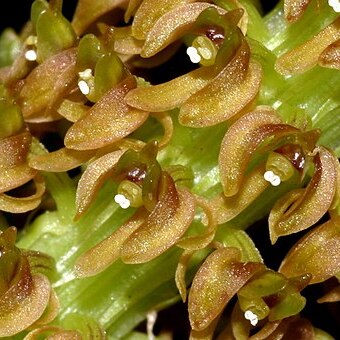Plants terrestrial, sometimes epiphytic. Pseudobulbs cylindric, 1-2 cm, fleshy, with several nodes, ± enclosed in membranous sheaths. Leaves 4 or 5, obliquely ovate-elliptic, ovate, or narrowly elliptic-lanceolate, 7-16(-25) × (2.5-)4-9 cm, base contracted into a sheathlike, amplexicaul petiole 3-5 cm, apex acuminate. Inflorescence erect; peduncle erect, 15-60 cm, very narrowly winged; rachis 5-15(-25) cm, many flowered; floral bracts ± reflexed, narrowly lanceolate, 2.5-5(-12) mm. Flowers purplish red to greenish yellow, relatively small; pedicel and ovary 2-3 mm. Dorsal sepal narrowly oblong, 3-3.5 × 1.1-1.2 mm, apex obtuse; lateral sepals obliquely ovate, 2-2.5 × 1.2-1.4 mm. Petals linear, 2.5-3.2 × ca. 0.7 mm, apex obtuse; lip ± broadly ovate, ca. 2 × 2.5 mm, concave, subcordate to truncate at base, apex 3-lobed; mid-lobe narrowly ovate, 0.7-1.1 mm, much longer than lateral lobes, apex obtuse. Column ca. 1.2 mm, stout. Capsule erect, obovoid-ellipsoid, 6-7 × 3-4 mm; fruiting pedicel 2-3 mm. Fl. May-Aug, fr. Aug-Dec. 2n = 26, 42.
More
Stems conical, 100–200 × 10–20 mm, each lasting 2 years. Leaves 3–6, apical, 100–300 × 50–90 mm, bright green; veins prominent, margins wavy. Flower stem 150–300 mm long, wiry, brittle, multiflowered. Flowers crowded, facing downwards, sepals and petals curving inwards, 5–6 × 5–6 mm, greenish, brown, reddish or purplish. Dorsal sepal 3.5–4 × 1–1.2 mm, decurved. Lateral sepals 3–3.5 × 1.3–1.5 mm, curved over labellum. Petals 3.5–4 × 0.8 mm, incurved between sepals. Labellum rectangular with a large central cavity, 2.2–2.5 × 2 mm, with 3 blunt, apical teeth, central point (midlobe) longest and upcurved; base deeply pouched.
Widespread and common; growing in rainforest and other wetter forests, sheltered stream banks in open forest and adjacent to swampy areas, often along edges of roads and tracks.

